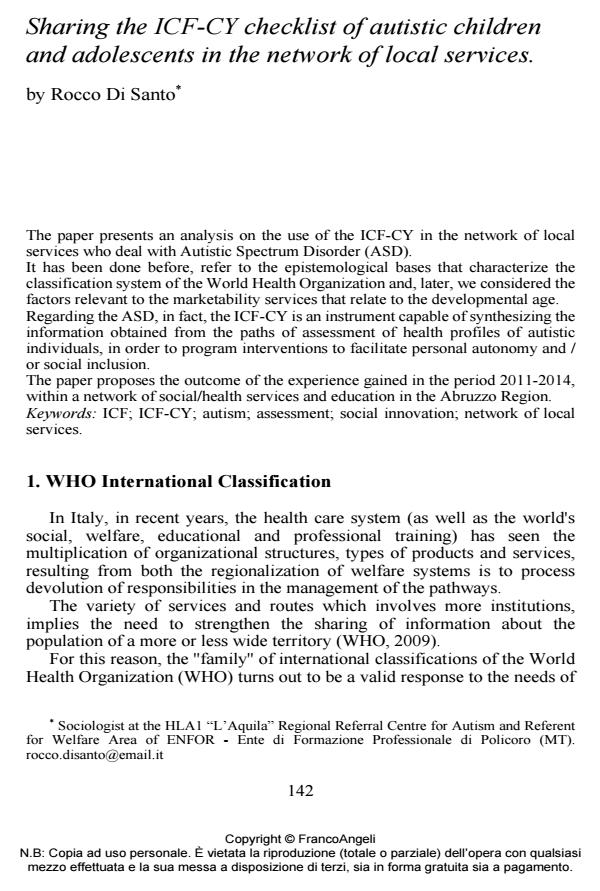Sharing the ICF-CY checklist of autistic children and adolescents in the network of local services.
Journal title SALUTE E SOCIETÀ
Author/s Rocco Di Santo
Publishing Year 2015 Issue 2015/1EN Language English
Pages 10 P. 142-151 File size 76 KB
DOI 10.3280/SES2015-001011EN
DOI is like a bar code for intellectual property: to have more infomation
click here
Below, you can see the article first page
If you want to buy this article in PDF format, you can do it, following the instructions to buy download credits

FrancoAngeli is member of Publishers International Linking Association, Inc (PILA), a not-for-profit association which run the CrossRef service enabling links to and from online scholarly content.
Technological innovation, medical progress, demographic change, increased chronicity and new health risks are some factors that need and require a change towards new models of health care. The contribution is intended to describe a project defined as "socially innovative", which relates to Cognitive Rehabilitation, an initiative to support families and patients with memory problems and Alzheimer's Neuro center of the Mediterranean Pozzilli, Isernia. The specialists of the health facility Molise triggered several editions of the "Cognitive Rehabilitation in patients with memory disorders and Group Psychotherapy for family" for those who live this experience in the first person and for those who are next as a caregiver or simply as members of the family. The analysis of this best practice has been investigated from the methodological point of view through a survey of qualitative in-depth interviews with patients and family members involved in this project, in order to highlight how this initiative has brought an innovation and a positive change, oriented towards new models of health care.
Keywords: Health, social innovation, dementia.
- American Psychiatric Association (2014). DSM-5 Manuale diagnostico e terapeutico dei disturbi mentali. Milano: Raffaello Cortina ed.
- Balboni G. (2003). Capacità discriminativa delle scale Vineland: profili di soggetti in età evolutiva con ritardo mentale. Bologna: Il Mulino. DOI: 10.1449/968
- Bickenbach J., Cieza A., Rauch A., Stucki G., eds. (2012). Core Set ICF. Manuale per la pratica clinica. Firenze: Giunti OS.
- Bickenbach J.E., Chatterji S., Badley E.M., Ustun T.B. (1999). Models of disablement, universalism and the international classification of impairments, disabilities and handicaps. Social Science & Medicine, 48: 1173-1187. DOI: 10.1016/S0277-9536(98)00441-9
- Caretto F., Bollini A., Cerbo R., Ciprietti R., Di Santo R., Sorge G. (2014). Manuale e Linee Guida per l’inserimento lavorativo di persone con Autismo. Available at: www.startautismo.it (Last accessed 02/06/2014).
- D’Orazio E. (2011). Il Piano europeo per la disabilità: minori in prima fila. Milano: FrancoAngeli. DOI: 10.3280/MG2010-003004
- De Giuli R. (2011). La classificazione della disabilità: dall’ICIDH all’ICF. Milano: FrancoAngeli. DOI: 10.3280/MG2010-003003
- De Polo G., Pradal M., Bortolot S. (2011). ICF-CY nei servizi per la disabilità. Indicazioni di metodo e prassi per l’inclusione. Milano: FrancoAngeli.
- Di Santo R. (2013). Sociologia della disabilità: teorie, modelli, attori e istituzioni. Milano: FrancoAngeli.
- Franzoni F., Hanau C., Cerati D.M. (2008). Progetti personalizzati per disabili: il caso dell’autismo. Bologna: Il Mulino. DOI: 10.1447/27905
- Ianes D. (2004). La diagnosi funzionale secondo l’ICF. Trento: Erickson.
- Ianes D., Cramerotti S. (2009). Il Piano Educativo Individualizzato – Progetto di Vita vol. I. Trento: Erickson.
- Leonardi M. (2005). Salute, disabilità, ICF e politiche sociosanitarie. Sociologia e politiche sociali, 8(3):73-95.
- Leonardi M., Bickenbach J., Ustun T.B., Kostanjsek N., Chatterji S. (2006). The definition of disability: what is in a name?. Lancet, 368: 1219-1221.
- Ryan D.J. (2000). Job search: handbook for people with disabilities. Indianapolis (IN): Jist.
- Santocchi E., Muratori F. (2012). L’autismo nel DSM-5. Torino: Il Pensiero Scientifico Editore. DOI: 10.1710/1193.13244
- Sparrow S.S., Balla D.A., Cicchetti D.V. (2003). Vineland Adaptive Behavior Scales. Firenze: Giunti OS.
- WHO (2002). Classificazione Internazionale delle Funzioni, della Disabilità e della Salute. Trento: Erickson.
- WHO (2007). Classificazione Internazionale delle Funzioni, della Disabilità e della Salute. Versione per bambini e adolescenti. Trento: Erickson.
- WHO e Regione Autonoma del Friuli Venezia Giulia (2009). Classificazione Internazionale delle Funzioni, della Disabilità e della Salute. Lo sviluppo e l’esperienza italiana. Trento: Erickson.
Rocco Di Santo, Sharing the ICF-CY checklist of autistic children and adolescents in the network of local services. in "SALUTE E SOCIETÀ" 1EN/2015, pp 142-151, DOI: 10.3280/SES2015-001011EN